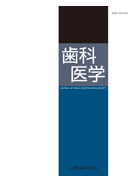Volume 68, Issue 3_4
Displaying 1-26 of 26 articles from this issue
- |<
- <
- 1
- >
- >|
-
Article type: Article
2005 Volume 68 Issue 3_4 Pages 241-252
Published: December 25, 2005
Released on J-STAGE: May 18, 2017
Download PDF (2333K) -
Article type: Article
2005 Volume 68 Issue 3_4 Pages 253-261
Published: December 25, 2005
Released on J-STAGE: May 18, 2017
Download PDF (1368K) -
Article type: Article
2005 Volume 68 Issue 3_4 Pages 262-267
Published: December 25, 2005
Released on J-STAGE: May 18, 2017
Download PDF (604K) -
Article type: Article
2005 Volume 68 Issue 3_4 Pages 268-272
Published: December 25, 2005
Released on J-STAGE: May 18, 2017
Download PDF (537K) -
Article type: Article
2005 Volume 68 Issue 3_4 Pages 273-282
Published: December 25, 2005
Released on J-STAGE: May 18, 2017
Download PDF (1206K)
-
Article type: Article
2005 Volume 68 Issue 3_4 Pages 283-
Published: December 25, 2005
Released on J-STAGE: May 18, 2017
Download PDF (111K) -
Article type: Article
2005 Volume 68 Issue 3_4 Pages 284-
Published: December 25, 2005
Released on J-STAGE: May 18, 2017
Download PDF (158K) -
Article type: Article
2005 Volume 68 Issue 3_4 Pages 285-
Published: December 25, 2005
Released on J-STAGE: May 18, 2017
Download PDF (184K) -
Article type: Article
2005 Volume 68 Issue 3_4 Pages 286-287
Published: December 25, 2005
Released on J-STAGE: May 18, 2017
Download PDF (267K) -
Article type: Article
2005 Volume 68 Issue 3_4 Pages 287-
Published: December 25, 2005
Released on J-STAGE: May 18, 2017
Download PDF (145K) -
Article type: Article
2005 Volume 68 Issue 3_4 Pages 288-
Published: December 25, 2005
Released on J-STAGE: May 18, 2017
Download PDF (165K) -
Article type: Article
2005 Volume 68 Issue 3_4 Pages 289-
Published: December 25, 2005
Released on J-STAGE: May 18, 2017
Download PDF (172K) -
Article type: Article
2005 Volume 68 Issue 3_4 Pages 290-
Published: December 25, 2005
Released on J-STAGE: May 18, 2017
Download PDF (167K) -
Article type: Article
2005 Volume 68 Issue 3_4 Pages 291-
Published: December 25, 2005
Released on J-STAGE: May 18, 2017
Download PDF (165K)
-
Article type: Article
2005 Volume 68 Issue 3_4 Pages 1-2
Published: December 25, 2005
Released on J-STAGE: May 18, 2017
Download PDF (221K) -
Article type: Article
2005 Volume 68 Issue 3_4 Pages 3-4
Published: December 25, 2005
Released on J-STAGE: May 18, 2017
Download PDF (232K) -
Article type: Article
2005 Volume 68 Issue 3_4 Pages 4-5
Published: December 25, 2005
Released on J-STAGE: May 18, 2017
Download PDF (233K) -
Article type: Article
2005 Volume 68 Issue 3_4 Pages 6-7
Published: December 25, 2005
Released on J-STAGE: May 18, 2017
Download PDF (249K) -
Article type: Article
2005 Volume 68 Issue 3_4 Pages 7-8
Published: December 25, 2005
Released on J-STAGE: May 18, 2017
Download PDF (263K) -
Article type: Article
2005 Volume 68 Issue 3_4 Pages 9-10
Published: December 25, 2005
Released on J-STAGE: May 18, 2017
Download PDF (243K) -
Article type: Article
2005 Volume 68 Issue 3_4 Pages 10-11
Published: December 25, 2005
Released on J-STAGE: May 18, 2017
Download PDF (232K) -
Article type: Article
2005 Volume 68 Issue 3_4 Pages 12-13
Published: December 25, 2005
Released on J-STAGE: May 18, 2017
Download PDF (218K) -
Article type: Article
2005 Volume 68 Issue 3_4 Pages 14-15
Published: December 25, 2005
Released on J-STAGE: May 18, 2017
Download PDF (237K) -
Article type: Article
2005 Volume 68 Issue 3_4 Pages 17-18
Published: December 25, 2005
Released on J-STAGE: May 18, 2017
Download PDF (245K) -
Article type: Article
2005 Volume 68 Issue 3_4 Pages 18-19
Published: December 25, 2005
Released on J-STAGE: May 18, 2017
Download PDF (262K) -
Article type: Article
2005 Volume 68 Issue 3_4 Pages 20-21
Published: December 25, 2005
Released on J-STAGE: May 18, 2017
Download PDF (244K)
- |<
- <
- 1
- >
- >|
